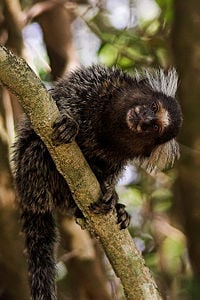Marmoset
| Marmosets[1] | ||||||||||||||
|---|---|---|---|---|---|---|---|---|---|---|---|---|---|---|
 Common Marmoset
(Callithrix (Callithrix) jacchus) | ||||||||||||||
| Scientific classification | ||||||||||||||
| ||||||||||||||
| Simia jacchus Linnaeus, 1758 | ||||||||||||||
|
18 species, see text |
Marmosets are New World monkeys of the genus Callithrix, which contains 18 species. The term marmoset is also used in reference to the Goeldi's Marmoset, Callimico goeldii, which is not part of the genus Callithrix and is not discussed in this article.
Most marmosets are about 20 cm long. Relative to other monkeys, they show some apparently primitive features: they have claws rather than nails, and tactile hairs on their wrists. They lack wisdom teeth, and their brain layout seems to be relatively primitive. Their body temperature is unusually variable, changing by up to 4 degrees Celsius (7 degrees Fahrenheit) in a day.
Marmosets are highly active, living in the upper canopy of forest trees, and feeding on insects, fruit and leaves. They have long lower incisors, which allow them to chew holes in tree trunks and branches to harvest the gum inside; some species are specialised feeders on gum.
Marmosets live in family groups of 3 to 15, consisting of one to two breeding females, an unrelated male, their offspring and occasionally extended family members and unrelated individuals. Their mating systems are highly variable and can include monogamy, polygyny and occasionally polyandry. In most species, fraternal twins are usually born, but triplets are not unknown. Like other callitrichines, marmosets are characterized by a high degree of cooperative care of the young and some food sharing and tolerated theft. Adult males, females other than the mother, and older offspring participate in carrying infants. Most groups scent mark and defend the edges of their ranges, but it is unclear if they are truly territorial, as group home ranges greatly overlap.
The monkey is mentioned in Shakespeare's Tempest, when Caliban says he will instruct his new master Stephano "how to snare the nimble marmoset" [for eating], on the no-man island where the play takes place (Act 2, Scene 2).
According to recent research, marmosets exhibit germline chimerism, which is not known to occur in nature in any other primate.[2]
Species list
- Subgenus Callithrix - Atlantic marmosets
- Common Marmoset, Callithrix (Callithrix) jacchus
- Black-tufted Marmoset, Callithrix (Callithrix) penicillata
- Wied's Marmoset, Callithrix (Callithrix) kuhlii
- White-headed Marmoset, Callithrix (Callithrix) geoffroyi
- Buffy-headed Marmoset, Callithrix (Callithrix) flaviceps
- Buffy-tufted Marmoset, Callithrix (Callithrix) aurita
- Subgenus Mico - Amazonian marmosets
- Rio Acari Marmoset, Callithrix (Mico) acariensis
- Manicore Marmoset, Callithrix (Mico) manicorensis
- Silvery Marmoset, Callithrix (Mico) argentata
- White Marmoset, Callithrix (Mico) leucippe
- Emilia's Marmoset, Callithrix (Mico) emiliae
- Black-headed Marmoset, Callithrix (Mico) nigriceps
- Marca's Marmoset, Callithrix (Mico) marcai
- Black-tailed Marmoset, Callithrix (Mico) melanura
- Santarem Marmoset, Callithrix (Mico) humeralifera
- Maués Marmoset, Callithrix (Mico) mauesi
- Gold-and-white Marmoset, Callithrix (Mico) chrysoleuca
- Hershkovitz's Marmoset, Callithrix (Mico) intermedia
- Satéré Marmoset, Callithrix (Mico) saterei
- Subgenus Callibella - Roosmalens' Dwarf Marmoset
- Roosmalens' Dwarf Marmoset, Callithrix (Callibella) humilis
- Subgenus Cebuella - Pygmy Marmoset
- Pygmy Marmoset, Callithrix (Cebuella) pygmaea
ReferencesISBN links support NWE through referral fees
- ↑ C. Groves, "Order Primates," "Order Monotremata," (and select other orders). Page(s) 129-133 in D. E. Wilson and D. M. Reeder, eds., Mammal Species of the World, 3rd edition, Johns Hopkins University Press (2005). ISBN 0801882214.
- ↑ Ross, C.N., French, J.A., and Ortí, G. (2007). Germ-line chimerism and paternal care in marmosets (Callithrix kuhlii). Proc. Natl. Acad. Sci. USA 104: 6278.
External links
Credits
New World Encyclopedia writers and editors rewrote and completed the Wikipedia article in accordance with New World Encyclopedia standards. This article abides by terms of the Creative Commons CC-by-sa 3.0 License (CC-by-sa), which may be used and disseminated with proper attribution. Credit is due under the terms of this license that can reference both the New World Encyclopedia contributors and the selfless volunteer contributors of the Wikimedia Foundation. To cite this article click here for a list of acceptable citing formats.The history of earlier contributions by wikipedians is accessible to researchers here:
The history of this article since it was imported to New World Encyclopedia:
Note: Some restrictions may apply to use of individual images which are separately licensed.
